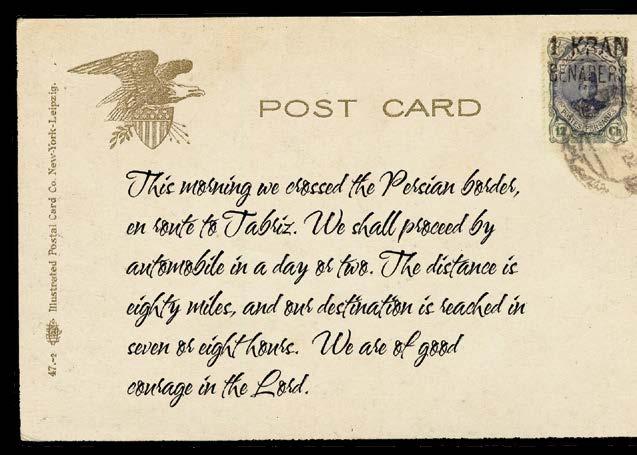
4 minute read
Entering Persia
On May 18, 1911, two young men stood shivering somewhere in theCaucasus Mountains in what was then Russian Armenia. Frank Oster, 29, and Henry Dirksen, 21, were about to attempt to take the Third Angel’s Message for the first time into the ancient nation of Persia.
Frank was born in Switzerland in 1881 and later emigrated to the United States with his family. Half a century later, a friend recalled that Frank “early had a desire to dedicate his life to God, and as a young minister he began preparing for mission service.”
As a student at Walla Walla College in 1909, Oster volunteered to go to “Persia” and sailed to Germany to undergo missionary training at the Adventist college. On the ship was another young American Adventist, Henry Dirksen. He had also studied at Walla Walla and then at the Foreign Mission Seminary in Takoma Park; he had been called to work in Germany.
In October 1910, Oster left Germany for Baku near the Russo-Persian border. Two months later Dirksen left Germany, having been called to join Oster. Their journeys were slow because of troubled political and social conditions in the Caucasus region of Russia. Once they arrived, they would spend the next six months in Baku.
Today Baku is the capital of Azerbaijan, which emerged from the breakup of the Soviet Union. Historically, Azerbaijan was split in two: a province in northern Persia and a province of the Russian Empire. Russian Azerbaijan was a good place to prepare for entering Iran for many Persian-speaking tribesmen lived on the Russian side of the border. There was also a small community of Adventists in Russian Azerbaijan, dating back to 1906. The two missionaries worked with this group of believers who were drawn from across the Caucasus.
Oster and Dirksen waited on clearance to enter Iran and finally it came. They headed for the ancient city of Tabriz by way of Tbilisi, the capital of Georgia, which was then part of the Russian Empire and where there was a small group of Adventist believers. They reported: “We spent five very profitable days with our people. . . . The Lord blessed our work, and hearts were melted by the Holy Spirit.” But this was just a brief stop before they moved on.
They finally crossed the Persian frontier on May 18, 1911, commencing Adventist mission in Iran. They sent a postcard to church leaders in the United States:
In fact, things did not go as smoothly as they hoped. Oster later described their arrival:
“Midnight found us in Julfa on the Russian side of the Aras River, the boundary line between Russia and Persia. In the morning after inspection by the customs officers we crossed in a small open rowboat in the midst of a heavy rainstorm to the Persian border. Here we loaded our baggage on donkeys and went to the automobile station. . . . We were informed, however, that the late rains had greatly damaged the road, so we were obliged, after a two-day’s wait, to drive to the next station.”
In Tabriz, Oster and Dirksen “began language studies, and made themselves acquainted with the manners and customs of the people by visiting the villages.” Dirksen returned to the United States, but in 1913 Oster’s wife, Florence, joined him and they settled in Maragheh, a town east of Lake Urmia. Florence put much effort into learning the language, including teaching English to local women as a way of learning from them!
But in 1914 World War I broke out and the Ottoman Empire declared war on Russia and the other Allies. Iran remained neutral, but the Turks and Russians mounted major campaigns in the Caucasus region. Bands of Kurdish tribesmen raided and killed in the plains around Lake Urmia. Florence had just given birth to her first child, Kenneth, but they, with thousands of others, became refugees, fleeing over the Sahand Mountains towards the safety of Tabriz. It was in the bitterly cold, snow-clad mountains that Frank, Florence, and Kenneth spent Christmas of 1914. They were then evacuated to Russia.
But by 1917 they were back in Tabriz, enduring difficult circumstances. Until after the end of the war, they only heard from family about once a year, and were, as Oster wrote, “cut off from all bank connections.” Twenty thousand people were sick with typhus and thousands died of starvation. Yet even now the Osters remained at their posts.
Ultimately, Frank served for 35 years in the Middle East, 27 of them in Iran, the rest in Turkey. He and his family seem to have had only two furloughs; but when they did return to the United States, they spent part of their time visiting camp meetings and churches to encourage young people to go as missionaries.
The Osters were the very embodiment of the bold, selfless missionary spirit that characterized this church from its early days and that continues to inspire thousands to follow in their footsteps in service around the world.
Until after the end of the war, they only heard from family about once a year, and were, as Oster wrote, “cut off from all bank connections.” Twenty thousand people were sick with typhus and thousands died of starvation. Yet even now the Osters remained at their posts.



Born to missionary parents in India, David Trim is the director of the Office of Archives, Statistics, and Research at the Seventh-day Adventist Church world headquarters. Visit www.AdventistArchives.org.

